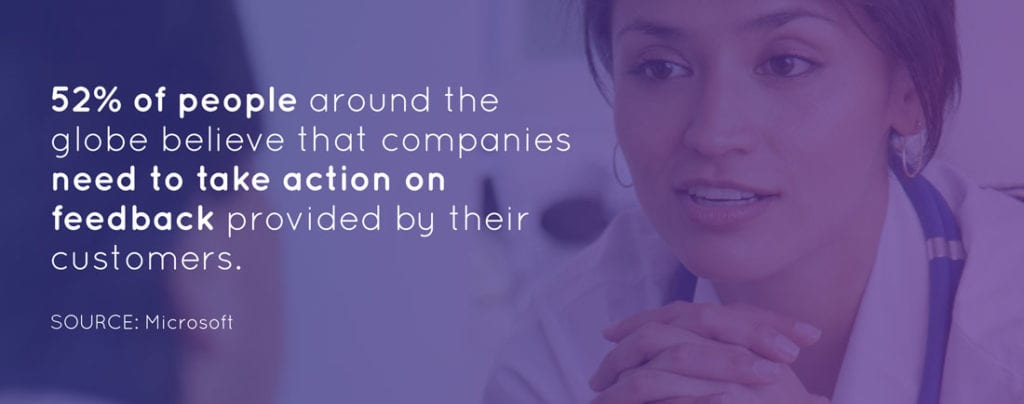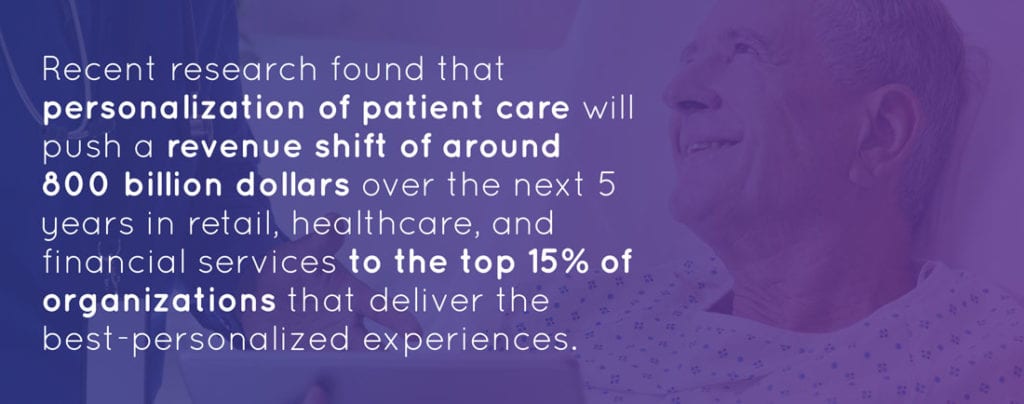Healthcare is a multi-trillion-dollar business in the United States. Despite all the money that flows into and through healthcare providers, the industry as a whole suffers from drastic fragmentation. This fragmentation appears in many different areas: technology, billing, payments, communications, and more.
Inefficient and ineffective communications have a negative impact on all other areas. When patients and providers alike lack a clear understanding of what’s going on with their care breakdowns become inevitable. This results in lower patient satisfaction, which can affect funding for some healthcare providers. But in an even broader sense, lack of information reduces the quality of care that patients receive or that patients think they receive.
There is a significant disconnect for healthcare consumers when it comes to customer satisfaction and customer experiences. Because, let’s face it, patients are simply customers with a different name. Other industries and businesses can be obsessive about customer satisfaction, but in healthcare it’s almost an afterthought. But healthcare patients don’t function in a vacuum. They often experience these satisfaction-obsessed companies at the same time they interact with healthcare providers. Patients expect similar experiences across the board, but it becomes very clear very quickly that the healthcare experience is inferior. As a result, healthcare providers end up fighting an uphill battle in terms of delivering quality communications and the type of customer experiences that patients expect.
With so much bureaucracy, regulation, and red tape, the more transparent a healthcare provider can be with its patients, the better positioned it will be to serve those individuals. Having the right communications tools in place facilitates transparency.
Utilizing the voice channel in tandem with an interactive voice response system (IVR) is one way to deliver rapid and efficient communications that gives patients the information they need in a convenient, customer-friendly way.
A study by Advisory Board projects that negative word-of-mouth, resulting from patients sharing their negative patient experiences with others via online or offline channels, could result in approximately $700K in lost revenue.
Healthcare Collections
There are a lot of moving parts in the world of healthcare collections, so the more streamlined and secure the process can be the better it is for everyone involved. When it comes to collections and payments healthcare providers face serious regulation. Oftentimes patient billing includes information about the services they received, which is protected healthcare information. Here, providers need to deal with HIPAA regulations.
More than 13 million records were breached in 2018.
SOURCE: HIPAA Journal
At the same time, when customers pay their bill(s) using a credit card, providers need to ensure that every payment channel protects the patient’s financial and credit card information. The credit card industry has its own certification for data security called PCI-DSS.
Therefore, to process patient payments and to maintain patient privacy and data security, healthcare collectors need to ensure that every collections channel is both HIPAA- and PCI-compliant.
Oftentimes, patients talk to and agent or front office employee when they pay their healthcare bills over the phone. This can be a very unsecure process that varies greatly from one provider to another. Having individuals take information over of the phone and jot down sensitive information on a piece of paper is not a secure transaction.
This is an area where an IVR service can streamline the collections process. Instead of relying on humans to accept and input sensitive financial information, an IVR payment processing application can automate the entire process. This provides a quick way for customers to pay their bills and it means less work for agents and less security risk for the healthcare provider in general.
Appointment Management
Everything in healthcare evolves out of interactions between providers and patients. So, making and keeping appointments is mission-critical for many healthcare providers.
But people miss appointments all the time. Or they show up late, which throws the rest of the day’s schedule out of whack. Being able to effectively manage appointments has a very real effect on day-to-day operations for healthcare providers.
Giving patients the ability to manage their appointments over the phone provides an accessible and straightforward way for them to make changes to their schedule. This also helps healthcare providers because you know in real-time what to expect from patients on a daily basis.
Missed appointments cost the U.S. healthcare system more than $150 billion a year.
SOURCE: ReferralMD
IVR applications can automate appointment management over the phone. This allows healthcare providers to offer their patients the ability to schedule new appointments, look up existing appointments, reschedule appointments, and cancel appointments. This is especially useful for patients looking for appointment information after-hours.
Another useful feature of IVR appointment management is patient notifications. Once a patient has an appointment time, the app can be designed to give them the option of receive an appointment reminder. Providers can to send reminders as SMS messages or as pre-recorded phone calls. These types of applications also give providers flexibility with regards to when reminders go out. That can be a day before the appointment, the morning of the appointment, or any other point in time that meets the needs of the facility and/or the patient.
Automating appointment management with the voice channel provides an extra layer of flexibility, transparency, and accessibility. By improving patient communications around appointments, healthcare providers can deliver the positive customer experiences patients expect.


Innovative Uses for Voice and IVR in Healthcare
IVR is a flexible technology and the ubiquity of telephones means that healthcare IVR applications offer a reliable means for transferring critical information for healthcare providers and patients.
Reduce Re-Admission Rates
Doctors and nurses don’t have time to follow up personally with every patient that gets discharged from the hospital. But an automated IVR application can. Providers can use IVR to present patients with common symptoms based on their condition. If a patient identifies a problem during a post-procedure call, that patient be automatically connected to a doctor or nurse to assess whether re-admission is necessary. With IVR, providers can identify post-procedure issues faster, which can reduce hospital re-admission rates.
Last year, nearly 18% of Medicare patients who had been hospitalized were readmitted within a month.
SOURCE: ReferralMD
Test Results
Healthcare providers can use IVR applications to collect medical information for testing and/or present patients with test results. Providers can use IVR applications to record personalized test results and attach that recording to a patient’s medical record. Once the recording is in the system, the application can call out to the patient and playback the recording. Providers can also use a combination of pre-recorded audio and text-to-speech to read back common test results. If patients have questions after receiving their results, providers can easily give callers the option of connecting directly to a nurse or other healthcare provider.
Asset Locator
Medical equipment can be both specialized and expensive. Many facilities can only afford a fixed number of pieces of medical equipment. Healthcare providers can use cloud IVR applications to locate specific pieces of equipment within their facility. For example, providers can assign an ID to each piece of equipment and room in the facility. When someone needs to use a specific piece of equipment, they call a number and input the device ID. In return, the caller hears the current location of the desired piece of equipment. This makes it quicker and easier to find critical medical equipment when time matters.
Prescription Information
Healthcare providers, pharmacies, or even insurance companies might want to automate the dissemination of prescription information. This may include things such as the name of a patient’s current medication, their current dosage, the number of remaining refills, or the name(s) of generic alternatives.
Patients can then call a phone number and retrieve this information at will. It’s also possible to integrate this type of application with other applications designed to order prescription refills. Pharmacies can use IVR automation to provide status updates to patients waiting for prescriptions to be filled and even send proactive notifications to let patients know when their prescription is ready to be picked up.
Collect Voice of the Customer Data
More and more individual companies and entire industries seek to improve customer communications and experiences using feedback from customers themselves. These voice of the customer (VoC) programs provide critical data that businesses use to drive improvements to their technology, communications, and operational workflows.
Historically, healthcare providers struggle to collect actionable feedback from patients, let alone analyze and implement improvements based on that data. IVR surveys provide a method for healthcare providers to engage patients directly and to generate strategies and lines of inquiry that will help to drive real improvements. IVR applications that allow healthcare providers to easily iterate their surveys allow for even more, granular feedback data. Providers can set and track metrics for specific interactions and outcomes and measure those against actual patient feedback.
IVR survey applications arm healthcare providers with both qualitative and quantitative patient feedback data. Using that data to improve communications can have a significant effect on providers and patients alike.


Personalization
What is personalization? It is the use of customer-specific information to create custom communications tailored to individuals. One of the most common ways that businesses increase engagement is through personalized communications. This is another area where healthcare patients get exposure to personalization from other sources and, in turn, expect the same experiences from healthcare providers.
Personalization means different things to different people and in different industries. For healthcare providers, one area to focus is on personal details. This can be as simple as using a customer’s name in a call prompt or pulling in their contact information from a database so they only have to confirm the data, instead of entering that information.
There are many reasons why healthcare providers would want to personalize communications for their patients. For example:
- Increase engagement: Patients are more likely to engage with communications tailored specifically to them.
- Improved efficiency: Understanding what information patients want and/or need and giving that to them in a timely fashion speeds up interactions. Getting information quickly makes patients happy.
- Foster loyalty: Make every patient feel as though their needs are a top priority. Couple that positive experience with fast service and patients will likely demonstrate greater trust and loyalty.
- Better customer experience: The combination of all of these factors result in a better customer experience. In an era where customer service and customer experience are major differentiators, providing great customer service can’t be overlooked.
Communications as Foundation
No matter which way you slice it, communications affect every aspect of the healthcare industry. It’s precisely this reason that it’s so important for healthcare providers to focus on communications. To find the right communications channels and the actively work to improve them and make sure they serve patients in necessary ways.
At the same time, IT infrastructure in healthcare is often a mishmash of different technologies. As the digital transformation progresses, healthcare operations need to evolve along with the technology. That’s why it’s critical to find digital solutions that first and foremost, solve problems. And yet, an ability to do the job well isn’t always enough. With limited funds and developer resources, healthcare providers require technology that is flexible in its own right: technology that can adapt to future industry needs, software that is easy to use and implement, and can provide the reliability, stability, and security necessary to meet all the needs of healthcare providers.
As if that’s not enough, the output of these technologies, the end-user experience, has to be one that is engaging for patients, one that provides them the service and information they need quickly and intuitively.
Focusing on the needs of patients through transparent, engaging communications benefits providers and patients alike. Automating these communications over the voice channel should be part of a broader communications approach dedicated to delivering positive customer experiences that are on par with what healthcare patients expect.
Ready to learn more? Schedule a demo.

